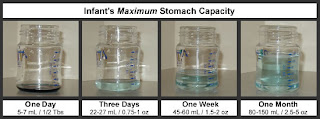

Read more here: The Importance of Colostrum
How much expressed breastmilk will baby need? Pls. keep in mind that this is just a general guideline. Every baby is different. Having good urine and stool output and gaining weight is important to know if baby is feeding well.
More info:
Pace feeds
"Breastfed babies are used to being able to control the flow of milk as they feed and may find it quite stressful feeding from a teat with a fast flow. It may look like the baby is very hungry and gulping the milk down. However, he might be swallowing fast so that he does not choke. One way to avoid this is to pace the feeds."Reasons for giving babies control of the pace of feeds:
It allows the baby to drink the amount he wants rather than the caregiver giving him too much.
By not giving a baby too much milk while he is away from his mother, it helps him to breastfeed when he is with his mother. This will help to keep his mother's milk supply.
If you give only the amount the baby needs, the mother does not need to spend as long expressing to keep up with the amount of milk the baby is being (over)fed.
How to pace feeds
Try not to feed the baby every time he is unhappy. A nappy change, cuddle or more attention may be what he needs. If he is obviously hungry though, offer a feed.
Watch for signs that the baby is hungry rather than feeding to a time schedule. The baby will get restless and may start sucking his fingers or moving his head on your chest when you pick him up. If he is past this stage, he may be crying and not stop when you comfort him.
Hold the baby in an upright position. This stops him taking too much milk at the start of the feed. Support the baby's head and neck with your hand rather than with your arm (see drawing at right).
Use a slow-flow teat.
Gently brush the teat down the middle of the baby's lips, particularly the bottom lip. This helps the baby to open his mouth wide, allowing you to place the whole teat into his mouth, like he would if he was breastfeeding. Do not push the teat into the baby's mouth. Let him take it himself.
Tip the bottom of the bottle up just far enough for the expressed breast milk (EBM) to fill the teat. As the feed goes on, you will need to let the baby gradually lean backwards more and more so that the teat stays filled with EBM. Keep the baby's head and neck lined up. At the end of the feed the bottle will be almost vertical.
Let the baby have rests every few minutes to make it more like a breastfeed. This will help stop the baby drinking too much too fast.
Allow the baby to decide when to finish the feed. He may not need to drink all the EBM in the bottle. It is better to do this than to worry about wasting a small amount of EBM."
http://www.mothersdirect.com.au/
More info and video: http://www.lactnews.com/products/videos
Microorganisms or good bacteria in mother's milk
Newspaper article. posted in Sunday The Star, 4th April 2010.
Click on image to enlarge




